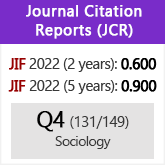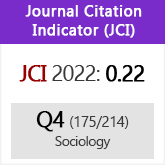The complexity and diversity of youth group figurations. Beyond the peer group
DOI:
https://doi.org/10.3989/ris.2023.81.1.21.148Keywords:
Figurations, Peer group, Sociality, Youth, Youth groupingsAbstract
The literature on youth sociality has emphasized the centrality of the peer group in youth relationships, pointing at its important functions to the passage to adult life. However, this symbolic monopoly of the peer group (group primary relationships) has led to the neglect of the plurality of youth groupings, as much as other forms of youth sociality that might be relevant in the lives of young people, including interpersonal relations and secondary groupings. Through the analysis of in-depth interviews with young people, carried out in 1994 and 2017, the most important figurations are identified and their characteristics and dynamics described. Results show that the peer group (base group) shares relevance with other forms of less intimate, but not less important, sociality, secondary groups, as well as with interpersonal relationships, as dyads. Furthermore, the current relevance of affinity relationships and some transformations in gender composition of youth groupings are also shown.
Downloads
References
Barruti, M. 1990. El mon del joves a Barcelona: Imatges i estils juvenils. Barcelona: Ajuntament de Barcelona.
Bauman, Z. 2003. Amor líquido. Acerca de la fragilidad de los vínculos humanos. México: Fondo de Cultura Económica.
Beck, U. y E. Beck-Gernsheim. 2003. La individualización: el individualismo institucionalizado y sus consecuencias sociales y políticas. Barcelona: Paidós.
Benedicto, J. 2017. "Los jóvenes ante la sociedad en la que viven: valores colectivos e implicación sociopolítica". Pp. 419-549 en Informe Juventud en España 2016, dirigido por J. Benedicto. Madrid: Instituto de la Juventud.
Bernardi, L., J. Huinink y R. A. Settersten. 2019. "The life course cube: A tool for studying lives". Advances in Life Course Research 41: 100258. https://doi.org/10.1016/j.alcr.2018.11.004 PMid:36738031
Bourdieu, P. 1979. La distinction: critique sociale du jugement. Paris: Éditions de Minuit.
Bourdieu, P. 1980. Le sens pratique. Paris: Éditions de Minuit.
Brown, B. B. y E. L. Dietz. 2009. "Informal peer groups in middle childhood and adolescence". Pp. 361-376 en Handbook of peer interaction, relationships and Groups, editado por K. H. Rubien, W. M. Bukowski y B. Laursen. Nueva York: Guildford Press.
Coleman, J. S. 1961. The adolescent society: the social life of the teenager and its impact on education. Glencoe, Illinois: The Free Press.
Collins, W. A. y B. Laursen. (2004). "Changing Relationships, Changing Youth: Interpersonal Contexts of Adolescent Development". The Journal of Early Adolescence 24(1): 55-62. https://doi.org/10.1177/0272431603260882
Conde, F. 1985. Las relaciones personales y familiares de los jóvenes. Madrid: Instituto de la Juventud.
Cooley, C. H. 1909. Social Organization: A Study of the Larger Mind. Nueva York: Charles Scribner's Sons. https://doi.org/10.1037/14788-000
Eisenstadt, S. N. 1956. From Generation to Generation: Age Groups and Social Structure. Glencoe, Illinois: The Free Press.
Elias, N. 1982. Sociología Fundamental. Barcelona: Gedisa.
Ellis, W. E. y L. Zarbatany. 2017. "Understanding Processes of Peer Clique Influence in Late Childhood and Early Adolescence". Child Development Perspectives 11(4): 227-232. https://doi.org/10.1111/cdep.12248. https://doi.org/10.1111/cdep.12248
Feixa, C. y L. Porzio. 2004. "Los estudios sobre culturas juveniles en España (1960-2003)". Revista de Estudios de Juventud 64: 9-28.
Fontes, B. A. S. M. y F. Andreu. 2015. "La contribución de Simmel a la sociología reticular". Estudios sociológicos 33(99): 527-551. Consulta 26 de mayo de 2022 (http://www.scielo.org.mx/scielo.php?script=sci_arttext&pid=S2448-64422015000300527&lng=es&tlng=es). https://doi.org/10.24201/es.2015v33n99.1386
Granovetter, M. 1983. "The Strength of Weak Ties: A Network Theory Revisited". Sociological Theory 1: 201-33. https://doi.org/10.2307/202051
Giddens, A. 1991. Modernity and self-identity: self and society in the late Modern Age. Londres: Polity Press.
Gillies, V. y R. Edwards. 2005. "Secondary Analysis in Exploring Family and Social Change: Addressing the Issue of Context". Forum: Qualitative Social Research 6(1): Art. 44, http://nbn-resolving.de/urn:nbn:de:0114-fqs0501444.
Glaser, B. G. y A. Strauss. 1967. The discovery of grounded theory. Chicago: Aldine Press.
González Oquendo, L. J. 2014. "La investigación sociológica figuracional de Norbert Elias: elementos conceptuales y metodológicos. Prácticas de oficio". Investigación y reflexión en Ciencias Sociales 14: 70-86. https://www.aacademica.org/luis.j.gonzalez.oquendo/2.
Gordo, Á., A. García Arnau, J. De Rivera y C. Díaz-Catalán. 2018. Jóvenes en la encrucijada digital. Itinerarios de socialización y desigualdad en los entornos digitales. Madrid: Ed. Morata-FAD.
Herlyn, I. 1980. "El grupo en los procesos de enseñanza y aprendizaje en la escuela". Pp. 239-259 en Introducción a la Sociología de los grupos, editado por B. Schäfers. Barcelona: Herder.
Hollingshead, A. B. 1949. Elmtown's Youth. Nueva York: John Wiley & Sons.
Humphreys, A. P. y P. K. Smith. 1987. "Rough-and-tumble, friendship, and dominance in school children: Evidence for continuity and change with age". Child Development 58: 201-212. https://doi.org/10.2307/1130302
Kitwood, T. M. 1980. Disclosures to a stranger. Adolescent values in an advanced industrial society. Londres: Routledge & Kegan Paul.
Leaper, C. 1994. "Exploring the consequences of gender segregation on social relationships". Pp. 67-86 en Childhood gender segregation: Causes and consequences, editado por C. Leaper. San Francisco: Jossey-Bass. https://doi.org/10.1002/cd.23219946507
Martín Criado, E. 2008. "El concepto de campo como herramienta metodológica". Revista Española de Investigaciones Sociológicas 123: 11-33. https://doi.org/10.2307/40184891
Megías, I. 2019. Protagonistas y espectadores: los discursos de los jóvenes españoles. Madrid: Fundación SM.
Navarro, M. y M. J. Mateo. 1993. Informe Juventud en España. Madrid: Instituto de la Juventud.
Requena Santos, F. 1994. Amigos y redes sociales. Elementos para una sociología de la amistad. Madrid: CIS.
Revilla, J.C. 1996. La identidad personal en la pluralidad de sus relatos: estudio sobre jóvenes. Tesis doctoral. Madrid: Universidad Complutense de Madrid.
Revilla, J.C. y F.J. Tovar 2006. "Jóvenes y adultos, ¿hasta qué punto diferentes? La influencia de la edad sobre las actitudes y valores". Panorama Social, 3: 120-133.
Rodríguez, E., I. Megías y E. Sánchez Moreno. 2002. Jóvenes y relaciones grupales. Dinámica relacional para los tiempos de trabajo y de ocio. Madrid: INJUVE.
Rose, A. J. y R. L. Smith. 2009. "Sex differences in peer relationships". Pp. 379-393 en Handbook of peer interaction, relationships and Groups, editado por K. H. Rubien, W. M. Bukowski y B. Laursen. Nueva York: Guildford Press.
Rubin, K. H., W. M. Bukowski, J. G. Parker y J. C. Bowker. 2008. "Peer Interactions, Relationships, and Group". Pp. 141-180 in Child and Adolescent Development: An Advanced Course, editado por W. Damon, R. Lerner, D. Kuhn, R. S. Siegler y N. Eisenberg. Nueva York: John Wiley. https://doi.org/10.1002/9780470147658.chpsy0310
Santamaría, E. 2010. "Buscarse la vida: trayectorias y experiencias de precariedad en el acceso al empleo de las personas jóvenes". Revista de Estudios de Juventud 89: 101-123.
Sherif, V. 2018. "Evaluating Preexisting Qualitative Research Data for Secondary Analysis". Forum: Qualitative Social Research 19(2): Art. 7.
Simmel, G. 1986. Sociología 1. Estudio sobre las formas de socialización. Madrid: Alianza Editorial.
Shrum, W. y N. H. Cheek. 1987. "Social structure during the School Years: Onset of the degrouping process". American Sociological Review 52: 218-223. https://doi.org/10.2307/2095450
Tejerina, B., D. Carbajo y M. Martínez. 2012. El fenómeno de las lonjas juveniles. Nuevos espacios de ocio y sociabilidad en Vitoria-Gasteiz. Leioa: Informes del CEIC.
Thrasher, F. M. 1927. The gang. Chicago: University of Chicago Press.
Whyte, W. F. 1943. Street corner society. Chicago: University of Chicago Press.
Published
How to Cite
Issue
Section
License
Copyright (c) 2023 Consejo Superior de Investigaciones Científicas (CSIC)

This work is licensed under a Creative Commons Attribution 4.0 International License.
© CSIC. Manuscripts published in both the printed and online versions of this Journal are the property of Consejo Superior de Investigaciones Científicas, and quoting this source is a requirement for any partial or full reproduction.All contents of this electronic edition, except where otherwise noted, are distributed under a “Creative Commons Attribution 4.0 International” (CC BY 4.0) License. You may read here the basic information and the legal text of the license. The indication of the CC BY 4.0 License must be expressly stated in this way when necessary.
Self-archiving in repositories, personal webpages or similar, of any version other than the published by the Editor, is not allowed.

















